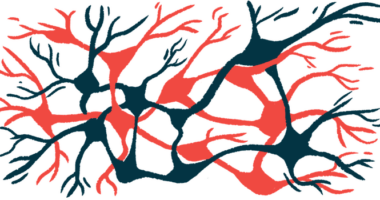MDA 2024: Blocking protein shows promise for genetic form of ALS
Inhibiting PTP sigma helped nerve survival, motor function in mouse model

Blocking a protein called PTP sigma led to better nerve survival and motor function in a mouse model of amyotrophic lateral sclerosis (ALS) caused by mutations in the C9ORF72 gene — leading the researchers to highlight this strategy for potentially treating this genetic ALS form.
Data from cell models suggest that reducing PTP sigma is protective because it activates a molecular pathway used to transport molecular cargo within nerve cells, which is required to move unwanted proteins to sites of degradation, pointing to this pathway as a possible therapeutic target.
“These exciting findings highlight the role of [this pathway] in the [disease development of this ALS form], offering a new direction for the therapy development of the disease,” the scientists wrote in an abstract detailing the research findings.
Zhe Zhang, PhD, a postdoctoral fellow at Johns Hopkins University, in Maryland, presented the findings in a talk titled “PTP [sigma]-Mediated PI3P Regulation as a Therapeutic Strategy for 9ORF72-ALS/FTD” at the Muscular Dystrophy Association (MDA) 2024 Clinical and Scientific Conference, held last week in Florida and virtually.
Seeking treatment strategies for genetic ALS due to C9ORF72 mutations
Though the causes of ALS are not fully understood, genetic mutations are responsible for some cases of the disease. Mutations in the gene C9ORF72 are the most common genetic cause of ALS.
Disease-causing mutations in C9ORF72 lead to the production of small proteins called dipeptide repeats, or DPRs. These small proteins can cause toxic effects in cells, and it’s thought that the toxic impacts of DPRs in nerve cells are the main reason that C9ORF72 mutations cause disease. One of the most toxic C9ORF72-derived DPRs is called poly-GR (poly-glycine-arginine).
With an eye toward identifying potential treatment strategies, Zhang and colleagues set out to find other genes that could modulate the toxic effects of poly-GR. The team conducted a screen in which the scientists basically inactivated random genes in nerve cells, then expressed poly-GR.
The toxic protein killed most, but not all, of the cells, and the researchers looked to see which genes had been inactivated in cells that survived.
“When you knock down these genes, it can significantly improve [poly]-GR-expressing neuron survival,” Zhang said.
One of the genes identified by this screen was PTP sigma, which provides instructions for making a protein with the same name. This protein is known to be involved in regulating the development and activity of nerve cells and also activates in a cellular recycling process called autophagy, helping it catch the researchers’ attention.
In further experiments, the team confirmed that reducing PTP sigma protein levels led to better survival in nerve cells expressing toxic poly-GR. Then they set out to identify exactly why this was happening.
The team showed that altering PTP sigma didn’t affect levels of the toxic poly-GR itself, which Zhang said suggests that “this rescue effect is not coming from lowering [levels of poly]-GR.” Instead, the beneficial effect of reducing PTP sigma “has to be associated with other functions related to PTP sigma,” Zhang said.
The PTP sigma protein is known to be important for regulating the activity of another protein called PI3P, which is important for coordinating shipments of molecular cargo between different parts of nerve cells. This includes the movement of unwanted or faulty proteins or cellular components into lysosomes, the cell’s recycling centers — needed to eliminate the toxic protein clumps that build up in ALS.
The scientists found that expressing poly-GR in nerve cells reduced levels of PI3P — but reducing PTP sigma reversed this effect. This suggests that “maybe PI3P level is important for neuron survival,” Zhang said.
Tests in cell models showed nerve-protecting effects
Further supporting this idea, the researchers showed that reducing PTP sigma was no longer protective when cells were treated with a PI3P-blocking drug. And conversely, treating cells with a compound that activates PI3P boosted survival in the face of toxic poly-GR.
“This is showing that the PI3P levels is critical for neuron survival with the presence of [poly]-GR,” Zhang said.
Additional tests in cell models showed that boosting the early endosomal pathway, which is one of the major molecular pathways that PI3P participates in to help move molecular cargo, had similar nerve-protecting effects to reducing PTP sigma or increasing PI3P.
These findings suggest that it’s this particular pathway that’s helping protect cells against poly-GR in these models — pointing to this pathway as a potential treatment target for C9ORF72-related ALS.
The researchers then conducted experiments in mice to see if a drug that blocks PTP sigma could reduce disease activity in animals expressing toxic poly-GR. The results showed that reducing PTP sigma led to less nerve death and less neuroinflammation, as well as better scores on tests of motor function.
Altogether, the scientists concluded, the results suggest a new biological strategy for treating this genetic form of ALS that warrants further study.








